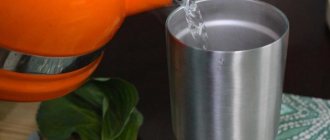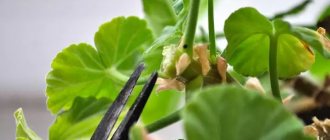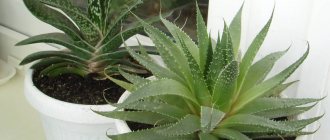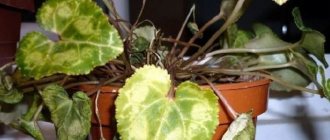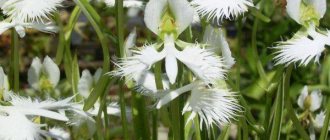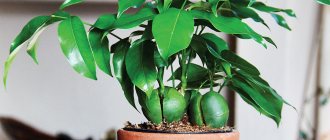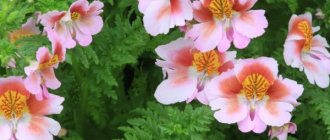Cyclamen refers to tuberous herbaceous plants that hibernate under unfavorable conditions.
Inexperienced gardeners perceive the withering of leaves as death and throw out the “dormant” plant. Origin. In the wild it grows in the southern regions of Europe, the Mediterranean and Asia Minor. Prefers foothill areas and regions with a mild climate, where winter temperatures do not fall below 10 degrees. It belongs to the family of primroses (lat. Primulaceae), to the subfamily myrsinaceae (lat. Myrsinaceae).
Size. The height of cyclamen does not exceed 30 cm , young flowering plants are from 10 cm. The size of leaves, flowers and the volume of the bush depends on the age and variety.
Lifespan and growth. The cyclamen bulb is a long-lived bulb and grows up to 30 years. The older the plant, the more magnificent the crown, but the size of the flowers becomes smaller and their number increases.
With the onset of winter, the plant becomes a popular gift. It is during the cold season that it pleases flower growers with its lush flowering. The unusual leaves and flowers of this plant delight lovers of flowering beauties.
Don't forget to check out the equally beautiful Gloriosa plant.
| Average growth rate. |
| Blooms from November to March. |
| The plant is suitable for an experienced grower. |
| Perennial. |
Growing principles
There is an opinion that domestic cyclamen species are very difficult to care for. But that's not true. The flower is quite unpretentious. It will not cause much trouble when growing if you follow simple rules:
- Cyclamen does not tolerate high temperatures. The optimal temperature for it during the flowering period is 8-12 C.
- Direct sunlight will cause leaves to yellow and fall off.
- The tuber should not be completely buried in the ground. One third should remain on the surface.
- The pot for planting should be small. The distance from the tuber to the walls of the pot should be 2-3 cm.
- Does not like excess salts in the soil with intensive use of fertilizers.
The peculiarity of cyclamen is that it blooms constantly from autumn to April-May. For three summer months, the flower enters a dormant period when the flowers fall off.
We talked in detail about how to care for cyclamen during and after flowering here.
How to water cyclamen at home - frequency and rules of watering
In the process of flower growth, two phases are distinguished: flowering and dormancy. During flowering, the soil should be moistened abundantly. At the end of this phase, moisture is reduced. After the leaves dry, the tuber becomes bare. During this period, watering is reduced to a minimum. It is not allowed to overdry the soil mixture in pots, but it is also not allowed to allow the liquid to stagnate.
Ficus Daniel - description and care rules
When transplanting, it is undesirable to allow the tubers to be completely buried. They must be above the soil surface. We must not forget about drainage.
Important! Feeding after transplantation will be required only after a month.
Photo
Look what cyclamen looks like in the photo, which is properly cared for:
How often to water indoor flowers in the fall
There is a fairly well-known rule that from May to September, house flowers are watered much more abundantly than during the rest of the year. This means that in the fall, watering and spraying of plants is gradually reduced, focusing on the temperature and humidity of the air, as well as the condition of the soil.
There are some other ways to determine soil moisture. For example, you can take a small handful of earth and knead it in your hands. If it breaks up into small particles, then the soil is dry and it’s time to water the plant. Another way is to tap the bottom of the pot. If the soil is dry, the sound will be louder than when tapping on a pot with wet soil. You can also check the soil using a moisture indicator, which, however, if there is a large amount of mineral salts in the soil, can be wrong.
Indoor flowers kept in ceramic dishes require much more moisture than others.
What to do with indoor plants in the fall A few important points to remember.
If in the spring plants need nitrogen fertilizers for growth, then in the second half of summer and early autumn they need phosphorus-potassium fertilizers - to strengthen the root system, resistance to temperature changes and various diseases. Therefore, combine watering with fertilizing, following the instructions for a particular fertilizer.
Is it often required during flowering and dormant periods?
There are no clear instructions on how often you should water cyclamen at home. The main indicator of the need for watering is the dryness of the top layer of soil. Just test the soil in the pot with your finger. If the finger immersed 2 phalanges into the ground remains dry, then it is time to water.
Another sign that watering is needed is when the leaves lose their elasticity. During the flowering period, 2 waterings per week will be sufficient. In summer - once every two weeks.
Common mistakes when caring and watering
The flowering period of cyclamen falls in winter and spring. But if, with the onset of summer, the flower continues to actively produce buds, you need to reduce watering and fertilizing. Novice gardeners try to cut off flower ovaries in order to force the flower to go into hibernation. It is strictly forbidden to do this, as the flower may die.
In the spring, when nutrients are stored before the dormant period, cracks may appear on the tubers. This is evidence that the flower was first dried out, and then they began to water it abundantly. The substrate must be watered regularly to avoid too sudden changes in humidity.
Watering into a tray
When bottom watering or watering in a tray, the flower will receive as much moisture as it needs. With proper care and attention, they are healthy and look great, bringing joy to others.
How to fertilize and feed?
During the flowering period, after summer hibernation, the plant needs to grow leaves, buds and flowers in a short period. The flower actively draws essential minerals from the soil. If the soil is depleted, then further growth and flowering are impossible, which means feeding is needed. Purchase special fertilizers for violets and other indoor plants at the flower shop. These can be mineral complexes with ammonium and potassium nitrate, superphosphates.
When choosing nitrogen, potassium and complex fertilizers, priority should be given to potassium ones. Experienced flower growers recommend taking the following preparations:
- Ideal.
- Blooms.
- Kemira Suite.
- Ferovit.
- Peace.
Opponents of chemical fertilizers prefer to use biological fertilizers. As a top dressing they add to the soil:
- yeast solution;
- wood ash;
- dried banana peel as a source of potassium;
- bird droppings;
- tincture of cattle manure;
- tincture from food waste.
On a note. To prevent diseases and provide mineral nutrition, the soil can be treated with an infusion of onion peels, garlic and other medicinal herbs.
Why cyclamen does not bloom - mistakes in care
The complete absence of flowering or its scarcity is most often associated with improper care of the plant.
Incorrect temperature setting
The ideal temperature for cyclamen flowering is 15-18 °C. Some varieties require lower temperatures - from +10 °C. At elevated temperatures, leaf stems begin to stretch, which negatively affects the well-being of the plant.
Note! Drooping leaves are a sign of a depressed state of cyclamen. A pot of cyclamen has no place on the windowsill above hot radiators
It is placed on a glazed balcony or between frames
A pot of cyclamen has no place on the windowsill above hot radiators. It is placed on a glazed balcony or between frames.
Errors in watering
Water for irrigation must be settled. When irrigating, moisture should not fall on the leaves or tuber. During flowering, the soil is constantly kept moist, but without waterlogging.
Important! To avoid mistakes when watering, water is poured into a tray, and the roots themselves regulate the desired level of humidity. To do this, create a drainage layer at the bottom of the container.
Watering with settled water
Incorrect planting or replanting of a plant
You can find out the reason for the lack of flowering of cyclamen by carefully examining the planted tuber in a pot. If it is completely buried in the ground, then it will not bloom. The tuber should protrude one third from the ground.
Additional Information. When replanting, the size of the container is selected according to the rule: the edge of the pot should be only 2-3 cm above the top of the tuber.
The reason for the lack of flowering may be a tuber affected by infectious diseases.
Incorrectly selected soil will prevent cyclamen from blooming fully.
First of all, pay attention to its acidity, the level of which should be pH 5.5-6.5
Not enough nutrients
If there is a lack of nutrition, the plant may not bloom at all. The leaves are the first to react to a lack of nutrition. They become smaller, turn yellow, and curl.
Cyclamen does not get enough nutrition
If the buds have time to form, and fertilizers have ceased to be supplied in sufficient quantities, the inflorescences begin to fall off.
Important! The imbalance of mineral elements is eliminated gradually; the plant does not tolerate the application of fertilizers in “shock” doses. When growing cyclamen from seed yourself, the sprouts are supported with a growth activator
When growing cyclamen from seed yourself, the sprouts are supported with a growth activator.
It is possible to explain why cyclamen does not bloom, but only leaves grow, by analyzing the composition of the fertilizer. Nitrogen fertilizers cause vigorous leaf growth to the detriment of flowering. An overdose of nitrogen can cause tuber rot.
Types of watering indoor plants
Cyclamen grows at home in pots. There are 3 main ways to water cyclamen growing in pots without causing harm to the leaves, tubers and flowers.
Using a watering can
Carefully place the spout of a small watering can or funnel against the inner wall of the pot and slowly move it around the circumference to moisten the soil. After an hour, excess water that has drained into the pan should be drained.
You should never water the aboveground part of the plant, leaves, stems, flowers, tubers. With such watering, the flower becomes sick with gray rot and other fungal diseases and dies.
Immersing the pot in liquid
- Fill the basin with water from the tap.
- Let sit for at least a day.
- Immerse the flower in water so that the edge of the pot protrudes 1 cm above the water.
- Leave until a characteristic wet sheen appears on the soil surface.
This means that the earth has absorbed the required amount of water. Then you can remove the pot and let the excess water drain.
Important! Do not put several pots in one basin and do not use the remaining water to water other plants. Diseases can be transmitted from one flower to another through the liquid.
Humidification from the tray
Some gardeners place the flower in a tray with low sides. A little water is poured into the pan. From the bottom of the tray, through the hole in the pot, pull a thread reaching the surface of the soil. Using osmosis, water is drawn from the pan along a thread and distributed evenly in the soil.
To prevent water from evaporating, the bottom of the tray is lined with moss, pebbles, and pieces of wood, which also serve as decorative elements.
Watch a video about watering cyclamen using a tray:
Diseases and pests
Due to the “capriciousness” of the plant, its maintenance is often accompanied by problems associated with non-compliance with care conditions.
- The leaves of the cyclamen have turned yellow. The leaves turn yellow as part of the natural process of shedding their greenery before dormancy. If the leaves begin to yellow unevenly, this may be due to direct sunlight. Rotting of the tuber is also accompanied by yellowing of the leaves. In this case, the yellowness begins from the cuttings. In any case, if the leaves turn yellow, you need to inspect the surface of the tuber. If the tuber is rotten, then the affected part is cut off and sprinkled with coal. Hard water causes the leaf to die, but the cutting remains normal.
- Leaves are falling. This phenomenon occurs in two cases: rotting of the tuber and transition to the dormant stage. It is necessary to examine and feel the tuber for softness and wateriness.
- The roots are rotting. The reason is waterlogging of the soil. Cyclamen is transplanted into new soil, completely clearing the old one.
- Slowly growing. Slow growth in cyclamen is observed in insufficient lighting and lack of nutrients in the soil.
- Doesn't bloom. If the cyclamen leaves are fine, but there are no flowers, then the pot chosen for replanting is too large. The use of nitrogen fertilizer also leads to inhibition of flowering and the formation of a large number of leaves.
- The leaves are drying. Drying of leaves, while maintaining general turgor, indicates too dry and hot air. It is necessary to increase the humidity, remove it from the heat source and avoid direct sunlight.
- Light spots appear on the leaves. Light-colored spots appear due to burns from the sun's rays, when the root system and tuber are damaged.
- Leaves curl. This is the plant's response to stress. The cause may be dirty air. Cyclamen does not tolerate smoke, car exhaust gases, or tobacco smoke. Acidic soil is also very stressful for the plant. Clay content in the soil is unacceptable. Stress occurs during active feeding during the period when the flower is trying to enter the dormant stage.
Pests
After purchasing a new plant, you need to keep it in isolation for about two weeks. The pest may not appear immediately.
- Shield. Sticky plaque and brown spots are the result of scale insects.
- Mealybug. These are gray small insects that infect the axils of leaves.
- Spider mite. It is easily recognized by the cobwebs on the leaves. The plant is affected by this insect in dry and warm air.
- Cyclamen mite. When affected, flowers and leaves grow underdeveloped and crooked. Sometimes the buds do not open and fall off. The infected plant is disposed of.
- Aphid. She drinks juice from leaves and peduncles, interfering with normal nutrition. Parts of the plant grow poorly. Aphids form clusters and are easy to spot on cuttings.
Learning to replant correctly
In order to correctly transplant cyclamen, use the following algorithm:
- Carefully shake out the contents of the pot.
- We remove rotten roots.
- We cut out the rotten part of the tuber to a healthy place.
- Dry the cut area using crushed activated carbon.
- Treat with Topaz or other fungicide.
- Plant in fresh sterilized soil for cyclamen.
Basic watering methods
Above
The most popular method of watering from above among gardeners is not very suitable for violets. It can be used when the flower is still young and has few leaves.
Water from a watering can or from a plastic bottle is carefully poured into the soil, making sure that it does not get into the center of the flower and does not wet the leaves.
Wetting the leaves can be especially detrimental to adult plants. Wet leaves in a draft or under the influence of the sun become damaged and burned, which can result in the death of the plant.
Drip irrigation
An alternative could be drip irrigation.
A container of water is fixed above the plant. For example, an ordinary plastic bottle. A silicone hose is inserted into the bottle. The other end of the hose is placed in the root area of the violet.
An IV system, which can be purchased at any pharmacy, is excellent for these purposes.
From one container, thanks to connectors and hose splitters, you can organize power supply for several violets.
The water supply is regulated so that it does not flow, but rather drips under the root of the plant. In this case, the moisture distribution occurs evenly. Excess moisture is excluded if the system is controlled.
In the absence of a drip system, you can use a regular medical syringe or a medical bulb. Water should be applied carefully between the leaves in thin streams.
Using pallets
If the plant is already mature with large leaves, the best way to water it is to water it in trays.
Water is poured into the tray under the pot and left for 30 minutes. This is enough for the flower to take as much moisture as it needs. At the end of the process, the water is poured out. Excess moisture in the lower areas can cause rot on the violet roots.
Through immersion
An alternative to watering in trays is the immersion method. The pot with the flower is placed in a container, which is filled with warm water 36-40 °C to two-thirds of the height of the pot. After the soil has darkened, the pot is removed from the water.
A variation of immersion irrigation is Texas irrigation. In this case, holes with a diameter of 3-4 mm are drilled at a height of 5 cm from the bottom of the pot. The space below the holes is filled with drainage. Typically, the role of drainage is performed by expanded clay pebbles of different sizes.
The substrate in which the violet is planted is placed on the drainage layer. A flower pot is immersed in water. The water level should not reach the side holes - they are intended only to supply oxygen to the roots. After the soil darkens, the pot is removed from the water.
Wick watering - how to make and use
Wick watering is considered the best way to supply moisture to the roots of violets growing in small containers.
When transplanting, a cord made of synthetic materials is placed at the bottom of the pot. A regular boot will do.
Natural materials are not suitable, since synthetics are more resistant to the aquatic environment. The top is filled with soil where the flower is planted.
The second end of the lace is lowered into the water. In this case, the flower should be located above the liquid level. The liquid should not touch the bottom of the pot.
Plastic cups into which the flower pot is inserted are perfect for organizing wick watering. Water will flow through the wick in the required quantity to the roots of the plant.
Important. In winter, this method should be used with caution, as the water quickly cools under the influence of low temperatures.
This is especially true if violets grow on the windowsill.
Very cold water has a detrimental effect on the root system of the plant - growth may slow down sharply, and inflorescences may not appear at all next year.
Alpine violet diseases
- If leaves and flowers begin to fade in winter, it means that the cyclamen is dying from too much moisture or water getting on the tuber. A flower can be saved by replanting. If the affected area was small, then the flower survives and is restored.
- If the tuber is covered with cracks. Most likely from excess moisture. Reduce the number of waterings and add 2 drops of Fitosporin to the water.
- With insufficient watering or dry warm indoor air, cyclamen may have diseased leaves, but the flowers remain large and strong. You should increase the number of waterings, humidify the air with a spray bottle, or move it to a more humid place.
You will find more information about cyclamen diseases and ways to combat them here.
Watering, fertilizing and caring for cyclamen at home does not require daily effort and special material costs. The plant is quite unpretentious and, with proper care, will delight you with beautiful flowers in the cold season, reminding you of the warm summers.
How to understand that a flower needs moisture
To understand whether cyclamen needs watering, you should carefully observe it at rest. As soon as new leaves and buds appear on the bushes, you can gradually increase the frequency of moistening and the volume of liquid. You should not suddenly change your care regimen. A large amount of moisture will lead to rotting of the plant.
Unpretentious cyclamen flower
The frequency of watering depends on the age of the bushes. Young specimens have weak roots, so they need frequent, but not very abundant moisture. Upon reaching three years of age, the cyclamen tuber becomes strong. It can store water and nutrients, so less frequent hydration is allowed. The volume of water should be slightly larger. The frequency of watering is affected by the following conditions:
- temperature in the house;
- air humidity;
- lighting (in a bright room the need for water is greater than in a darkened room).
The flower loves rooms with high humidity. The lighting should be diffused, the optimal temperature range is from +10 to +20 degrees.
Note! If cyclamen is given the brightest and coolest place in the house, it will thank you with lush flowering.
How to transplant cyclamen
Alpine violets are transplanted every two to three years. During this period, the tuber manages to grow a little and the previous container becomes too small for it. Usually this procedure is carried out just before the flower awakens, when the buds begin to come to life. Transplants are also recommended after purchasing the plant. The easiest way, if the plant is healthy, is to simply transfer it from the old pot to a new one and pour soil into the voids.
Transfer
Soil for cyclamen
To grow cyclamens, nutritious, water- and breathable soil is used. This soil mixture can be purchased in stores or prepared yourself.
For “artisanal” preparation you will need:
- sand;
- peat;
- humus;
- leaf soil.
These components are mixed in a ratio of 1:1:1:3. The soil must be disinfected, since cyclamen tubers are very susceptible to fungal diseases. A thick drainage layer is placed at the bottom of the pot.
Pot
If the transplant is planned, then take a pot two to three centimeters wider than the previous one. In general, for cyclamens it is better to take containers that are wider than deeper. Since the root system of these plants is not the largest, and the tuber sits high, water often stagnates in the lower part of high pots, which leads to bad consequences. The container for cyclamen should have several holes so that excess moisture can drain well. For the youngest plants, a pot with a diameter of 8 cm is enough, and for older plants no more than 15.
Types of cyclamens
The cyclamen genus belongs to the primrose family. Representatives of this group are widespread in Europe and the Middle East. In the wild, the plant clearly gravitates to mountainous areas with specific conditions - moderate seasonal humidity and good lighting. In this case, active flowering begins with cold weather. Like most primroses, cyclamens have distinct growing seasons throughout the year, associated with seasonal climate changes.
The name of cyclamen species comes from the geographical location of their range:
- Persian;
- Kosian;
- Alpine;
- Greek;
- Cypriot;
- African;
- European (magenta);
- Colchian
All species are united by similar ecology and plant structure. Cyclamen is distinguished by the presence of a massive tuber, fairly large leaves in the shape of an egg or heart, as well as tall peduncles. The flowers themselves consist of white, pink (various shades) or red petals. The roots of cyclamen grow over the entire surface of the tuber or, as, for example, in the purple tuber, only from the very bottom.
Cyclamen flowers
Based on European, Greek, Persian and African cyclamen, breeders have developed many garden varieties and hybrids, distinguished by a variety of colors and flower sizes.
Botanical description of the plant
The herbaceous perennial comes from the countries of the Mediterranean region and is also found in northern Africa.
Its characteristic features are:
- root in the form of a flat-round tuber with a diameter of up to 15 cm;
- leathery, green, heart-shaped leaves with a characteristic silvery pattern;
- leaf petiole is long, red-brown;
- peduncle up to 20 cm long;
- a flower of 5 petals with a bent lower petal, reminiscent of a butterfly;
- flowers are white, shades of pink and red, purple;
- fruit in the form of a capsule with seeds.
Other names for the plant are alpine violet or dryer.
There are standard varieties with a height of about 30 cm, as well as miniature fragrant cyclamen with a height of up to 15 cm. Did you know? The word cyclamen comes from the Greek cyclos, meaning circle, and refers to the shape of the tuber.
Another name for the flower is “pork bread”: in the book of Ambodik, Catherine II’s physician, “Medical Substance Studies” of 1758, the search for and eating of cyclamen tubers by pigs is described.
A dense rosette of leaves and flowers grows from the top of the tuber; in some species this occurs simultaneously. Prolonged flowering and growth of the plant occur during the cool period from autumn to spring. After flowering, the peduncle gradually twists into a spiral and lays the seed box on the ground. Then the leaves fall off and the flower goes into a dormant period.
Lighting
In nature, this plant prefers to grow in open spaces, due to which it receives a large amount of light. That is why it is necessary to choose a window in the apartment that will face the southwest or south side. Thus, the place for keeping the culture should be well lit throughout the day. There is no need to block the window with tulle or a curtain, since the sun's rays do not cause any harm to either the flowers or leaves of Kalanchoe.
There is another secret, thanks to which you can achieve the fastest possible formation of buds from a plant. Being a short-day crop, it prepares to bloom under approximately 10-12 hours of light per day. If you isolate Kalanchoe for 1 month from the sun for the rest of the time, you can wait for the formation of buds.
What to water with
One of the watering methods that gardeners like to use at home involves using a basin or bucket. Water is poured into them and left for about 12 hours. Then a container with cyclamen is placed there almost to the brim. Wait until the soil begins to shine with moisture, then remove the container and wait until the excess liquid drains through the drainage holes. The plant must be watered with lukewarm water.
Even for watering, the liquid must be clean, settled and, most importantly, soft. To prevent rotting, it is recommended to add a few drops of Fitosporin to it. In addition to a competent watering procedure, caring for your beautiful cyclamen requires adding weak fertilizer solutions to the soil, including such well-known ones as Peace, Ideal, Ferovit, Tsvetovit, Kemira-lux. There is no need to overfeed the plant so that it does not drive away the lush green foliage to the detriment of the flowers.
Answers to frequently asked questions
Perhaps the flower has entered its dormant period. It is necessary to gradually reduce watering. Cut off dried leaves and flower stalks. Place the flower pot in a cool place.
This happens with a newly purchased flower that seemed healthy. Changes in conditions of detention have an effect
Pay attention to the air temperature, light and water for irrigation. An east or west window is suitable for living. Perhaps the flower was attacked by pests or diseases
Carry out appropriate processing
Perhaps the flower was attacked by pests or diseases. Appropriate processing is carried out.
The reason is pests, spider mites or cyclamen mites. They thrive in dry, hot air. Cyclamen is treated with an insecticide solution, the temperature is reduced, and the air around the plant is moistened.
This is a fungal infection. The plant needs to be saved urgently. Removing dead parts, disinfecting in a fungicide solution, drying, transplanting the cyclamen into another pot and new soil will help.
It is not necessary. The flower itself will decide when it is time for it to rest.
The air temperature has increased. Place the flower pot closer to the glass, where the temperature is lower than in the room. A saucer of water on the windowsill and spraying the air around will help to humidify the air.
This is wet rot. You will have to part with the plant. There is no cure for this situation.
